Tuesday, August 28, 2012 - 07:35 AM UTC
Frituur Zorro has sent us news of their third instalment Frituur Zorro covering the uses military vehicles from World War Two were put to after the war ended.
In this latest edition of Frituur Zorro 3 from Frituur Zorro they show us the uses World War Two vehicles both Allied and Axis were put to up to and during the 70ís. With 167 pages of which 145 concentrate on Allied vehicles and 22 on Axis vehicles you should find something to appeal and encourage you to try out your scratch building skills. Here is some information from Frituur Zorro
The Summer of 1945. The fighting in Western-Europe has finally ended and the allied 'fighting-machine' has come to a halt. This is also the case for the numerous military vehicles which have suddenly become redundant. American, British and Canadian trucks were 'moth-balled' in enormous motor-pools. However, many allied and a few German military vehicles were given a new lease of life and were transformed for their new tasks. They would find their way to a myriad of small companies; builders, garages, fairgrounds, circuses and (especially in Belgium) 'Frietkotten', roadside 'Chippy's'. More often than not, their rudimentary transformation was left to the local blacksmith. The result being that the original vehicle often became barely recognisable. In the Netherlands the GMC's and other vehicles have all but disappeared from the scene. However, in Belgium they could still be found on almost every street corner. In search of these last remaining 'survivors', in the nineteen-seventies, Theo Barten en Maarten Swarts drove criss-cross through Belgium, Northern-France, the Netherlands and the then Eastern-block countries. From their efforts the resulting photographs capture for posterity these unique vehicles in street scenes during that period. Especially interesting are the hand painted signs on some of the vehicles giving the photos a truly unique atmosphere. The name on one of these signs was chosen as the title of these three books, 'Frituur Zorro' ('Chippy Zorro'). We discovered this wonderful sign on a recovered Austin K2 lorry which had been given the peacetime-role of 'mobile chippy' in Vilvoorde, Belgium.
Maarten Swarts and Theo Barten both studied at the Academy of Fine Arts in Breda. Their mutual love for veteran trucks led them to join forces. This resulted in a decade long photographic sojourn in search of old second World War 'soft-skin' vehicles.
Published by Narwal editors.
Three volumes of 172 pages, 21 x 28 cm, hardcover. Each volume contains 250 high quality black and white photos Published in Dutch and English Volume
1: Allied vehicles.
ISBN 978-90-9025502-6.
Volume 2: German, French, Russian, Czech and Italian vehicles. Alied vehicles.
ISBN 978-90-817110-1-2.
Volume 3: 145 pages Allied vehicles, 22 pages French, Czech and German vehicles.
ISBN 978-90-817110-0-5.
FRITUUR ZORRO IS NOW COMPLETE
The books can be ordered on the website and are not for sale in bookshops.
Frituur Zorro Webpage (LINK)
The Summer of 1945. The fighting in Western-Europe has finally ended and the allied 'fighting-machine' has come to a halt. This is also the case for the numerous military vehicles which have suddenly become redundant. American, British and Canadian trucks were 'moth-balled' in enormous motor-pools. However, many allied and a few German military vehicles were given a new lease of life and were transformed for their new tasks. They would find their way to a myriad of small companies; builders, garages, fairgrounds, circuses and (especially in Belgium) 'Frietkotten', roadside 'Chippy's'. More often than not, their rudimentary transformation was left to the local blacksmith. The result being that the original vehicle often became barely recognisable. In the Netherlands the GMC's and other vehicles have all but disappeared from the scene. However, in Belgium they could still be found on almost every street corner. In search of these last remaining 'survivors', in the nineteen-seventies, Theo Barten en Maarten Swarts drove criss-cross through Belgium, Northern-France, the Netherlands and the then Eastern-block countries. From their efforts the resulting photographs capture for posterity these unique vehicles in street scenes during that period. Especially interesting are the hand painted signs on some of the vehicles giving the photos a truly unique atmosphere. The name on one of these signs was chosen as the title of these three books, 'Frituur Zorro' ('Chippy Zorro'). We discovered this wonderful sign on a recovered Austin K2 lorry which had been given the peacetime-role of 'mobile chippy' in Vilvoorde, Belgium.
Maarten Swarts and Theo Barten both studied at the Academy of Fine Arts in Breda. Their mutual love for veteran trucks led them to join forces. This resulted in a decade long photographic sojourn in search of old second World War 'soft-skin' vehicles.
Published by Narwal editors.
Three volumes of 172 pages, 21 x 28 cm, hardcover. Each volume contains 250 high quality black and white photos Published in Dutch and English Volume
1: Allied vehicles.
ISBN 978-90-9025502-6.
Volume 2: German, French, Russian, Czech and Italian vehicles. Alied vehicles.
ISBN 978-90-817110-1-2.
Volume 3: 145 pages Allied vehicles, 22 pages French, Czech and German vehicles.
ISBN 978-90-817110-0-5.
FRITUUR ZORRO IS NOW COMPLETE
The books can be ordered on the website and are not for sale in bookshops.
Frituur Zorro Webpage (LINK)
Click Star to Rate
Only 1 reader has rated this.
THIS STORY HAS BEEN READ 5,067 TIMES.
| Frituur Zorro Reviews | MORE |
| Frituur Zorro - Volume 3 by Jim Starkweather | |
| Frituur Zorro Volume 2 by Jim Rae | of 3 ratings, 100% found this helpful | |
| Frituur Zorro by Peter Wood | of 3 ratings, 100% found this helpful | |





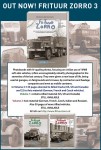
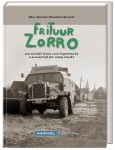
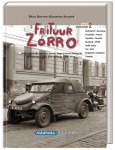
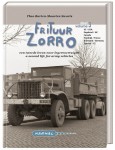





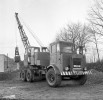




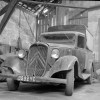
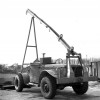



Comments